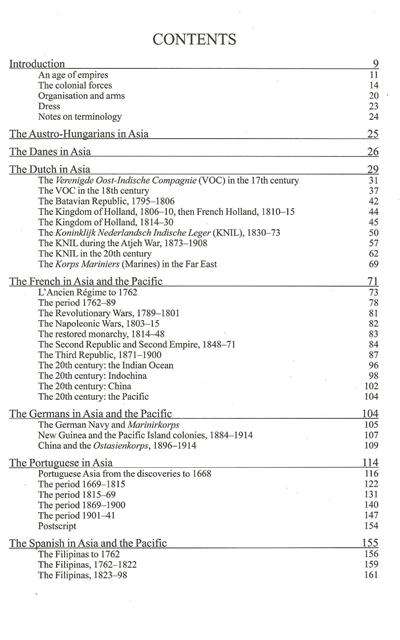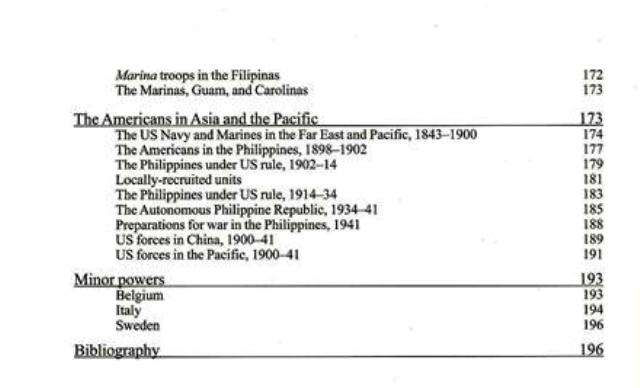Non-British Colonial Armies in Asia
I picked up this book in October when it was first released. The author is Peter Abbott who has written a number of other books for Foundry (notably Colonial Armies In Africa), Raider Games and Osprey. With the exception of the other Foundry book his work deals with subjects post 1900. Approximately 86 pages of the 196 pages of this volume deal with subjects from c.1850 or so to 1941.
It retails for £35.01 (why the 1 p?) from Foundry, although can be purchased for less during their regular sales or from other online vendors.
 |
| The cover |
I have all the other Foundry publications, with the exception of the one on Tudor England. The quality of the publication is what we have come to expect from Foundry. The Foundry site states:
The latest in our acclaimed military series of A4 sized hardbacks with traditional linen and gilt binding features the armies of the Austro-Hungarian Empire, Denmark, The Netherlands, France, Germany, Portugal, Spain, America, Belgium, Italy and Sweden!
Illustrations include 243 figures, 53 illustrations, 4 maps.
This book traces the developments in the structure, armament, and uniforms of the armies maintained by the imperial powers in Asia throughout the colonial period, with illustrative order of battle material wherever possible.The evolutionary development of the armies which maintained the colonial powers’ extraordinary ascendency in the East for four and a half centuries has seldom been surveyed as a whole, and certainly not in the kind of organisational detail included in this book.
 |
| Contents page 1 |
 |
| Contents page 2 |
There are no colour illustrations and, unfortunately, no illustrations of flags. I had purchased the book hoping for the latter.
I have to say that I haven't read any other of the author's books despite owning his earlier Foundry book and an Osprey on WWI East Africa. I certainly don't have the knowledge to comment on the research regarding anything outside of India. On that basis, the book is a sound introduction to those areas I don't know anything about. I did notice that there is no information on Japan, as those forces will be covered in a subsequent volume, as will the British.
As regards SYW India, well I did have a few issues. These included:
- Cross checking the source material was not always easy. Some of the internet sources were not current when I checked (the Danes in particular).
- It was difficult to locate relevant information on occasion. For example, the only reference to the Goan Portuguese I could see was in captions, not the main text.
- Important pictorial sources referred to were not necessarily illustrated. Again, in respect to the Danes the Tranquebar Dug - a rug made in India c.1740 illustrating Danish troops - wasn't illustrated.
- I thought the 4 maps were pretty useless and that the space could have been better used (but that's just my opinion).
- Lack of flag information.
What I found good about the book was:
- The extensive background on the Dutch East Indies Company which I had only seen in a much more abridged form. There are 28 pages covering the period up to 1878 and 15 pages up to and including 1941.
- There is also a good analysis of French uniforms in India (and how difficult it was to keep the troops provided with one). The treatment of De Bussy's army is short but very good, dealing with the changes in uniform, unlike another publication I keep threatening to review.
- It consolidates a lot of information which can be difficult to find without extensive reading.
Information on the period, is difficult to obtain and the author has done a very good job researching. He certainly includes some information on the Dutch I was not aware of. There is information omitted from the book that I have found elsewhere (again on those pesky Dutch!). Having said that, considering the uncertainty of uniform details and the immense size of the period the book covers the author has done a great job.
I would highly recommend the book as it consolidates a lot of information that is otherwise difficult to find. You may not always agree with the author's conclusions on a topic, but usually the information is there to form your own opinion. And a few colour plates, as with all in this series, would be nice.





Good review, much agreement with the assessment.
ReplyDeleteI actually do have the Tudor book. That means I am better than you.
I win.:)
PC
I've the Tudor book too - I win!
ReplyDeleteLovely assessment. I'll place this on the wish list.
Cheers,
Helen
Ok - 2 winners : )
ReplyDeleteHad another book arrive today with some nice Dutch stuff in it. Including onfo on Dutch sepoy types : )
Despite the price tag I'll have to get myself a copy ...
ReplyDeleteI do notice there is a sale on again - 20% off when the code is entered.
ReplyDeletegwz
I have just finished it this afternoon. My favourites were the Portuguese, especially as I got the two books 300 Anos Portuguese uniforms and 400 years uniforms at Macao too:-)) Great ideas for future projects.
ReplyDeletecheers
uwe